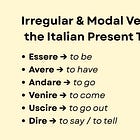Let’s be honest, grammar can feel a little dry. But the Italian present indicative tense is the heart of conversation. It’s what you use when you're ordering a coffee, talking about your day, or telling someone you love them. If you want to speak Italian today, you need the present tense.
So let’s make this simple, fun, and full of examples.
What is the Present Indicative Tense?
The present indicative tense in Italian (il presente indicativo) is how you talk about:
what’s happening right now
what happens regularly
what’s happening soon (even in the future)
Think of it as your go-to tense for real life.
“Io mangio una pizza.” → I’m eating a pizza.
“Ogni mattina bevo il caffè.” → Every morning I drink coffee.
“Domani vado a Roma.” → Tomorrow I’m going to Rome.
Wait, what? Tomorrow? That’s right! Italians often use the present tense for near-future plans. Context does the work!
The Big Three Verb Types
Most Italian verbs fall into three categories, based on their endings:
-are like parlare (to speak)
-ere like leggere (to read)
-ire like dormire (to sleep)
Let’s take parlare as our first friend. If you want to say “I speak,” just say:
“Io parlo italiano.” → I speak Italian.
Now change the subject:
“Tu parli inglese?” → Do you speak English?
“Luca parla troppo!” → Luca talks too much!
“Noi parliamo con la nonna.” → We talk to grandma.
“Voi parlate francese?” → Do you all speak French?
“Loro parlano sempre di cibo.” → They always talk about food.
Each person (I, you, he/she, we, etc.) has its own special ending. But don’t worry, we'll learn these naturally through practice.
Real-World Examples with Common Verbs
🍽 Mangiare – to eat
“Mangio alle otto.” → I eat at eight.
“Marco mangia la pasta ogni giorno.” → Marco eats pasta every day.
“Mangiamo insieme?” → Shall we eat together?
📖 Leggere – to read
“Leggo un libro bellissimo.” → I’m reading a beautiful book.
“I bambini leggono a scuola.” → The kids read at school.
😴 Dormire – to sleep
“Dormi bene?” → Do you sleep well?
“Dormiamo fino a tardi la domenica.” → We sleep in on Sundays.
✈️ Andare – to go (irregular!)
“Vado al lavoro.” → I go to work.
“Andiamo al cinema stasera?” → Are we going to the cinema tonight?
“Dove vanno i tuoi amici?” → Where are your friends going?
Quick Note: You Don’t Always Need “Io, Tu, Lui…”
In Italian, you can usually skip the subject because the verb already tells you who’s doing what.
Instead of:
“Io parlo italiano.”
You can just say:
“Parlo italiano.”
It’s faster, it’s natural, and it sounds more Italian.
Bonus: Using the Present Tense for the Future
We hinted at this earlier, but yes, you can totally use the present indicative for things happening soon.
“Domani prendo il treno.” → Tomorrow I take the train.
“Stasera cuciniamo la pizza.” → Tonight we’re making pizza.
Italians don’t always say andrò, farò, prenderò (future tense). In conversation, they just go with the present.
Irregular Verbs: A Few You Should Know
Some verbs love to break the rules—but they’re used all the time, so it’s worth memorizing a few.
Essere (to be): “Sono felice.” → I’m happy.
Avere (to have): “Hai un minuto?” → Do you have a minute?
Fare (to do/make): “Cosa fai?” → What are you doing?
Potere (can): “Posso entrare?” → Can I come in?
These don’t follow the usual patterns, but they show up in every conversation.
Let’s Put It All Together
Here’s a short dialogue full of present tense verbs:
Anna: Ciao! Cosa fai stasera?
Luca: Esco con gli amici. Andiamo al ristorante.
Anna: Che bello! Io cucino a casa.
Luca: Mangiamo insieme domani?
Anna: Volentieri!
English translation:
Anna: Hi! What are you doing tonight?
Luca: I’m going out with friends. We’re going to a restaurant.
Anna: How nice! I’m cooking at home.
Luca: Shall we eat together tomorrow?
Anna: Gladly!
Look at all the verbs: fai, esco, andiamo, cucino, mangiamo. All in the present indicative tense. No future tense. No complicated grammar. Just real Italian.
Final Tips to Master the Present Tense
Use it every day – Even simple phrases like “Bevo il caffè” will reinforce it.
Speak out loud – Hearing yourself helps memory.
Notice it in the wild – Listen to Italian podcasts, YouTube, or shows and try to pick out present tense verbs.
Be patient – You don’t need to be perfect to be understood. Just speak.
Next step? Learn about irregular and modal verbs in the present tense and expand your vocabulary even further.



